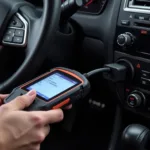Understanding how to use a car diagnostic computer can seem daunting, but it doesn’t have to be. These powerful tools offer a window into your car’s inner workings, empowering you to diagnose and potentially even fix issues yourself. This comprehensive guide will demystify the process, equipping you with the knowledge to confidently navigate the world of car diagnostics.
Getting Started with Car Diagnostic Computers
Before diving into the how-to, let’s clarify what a car diagnostic computer does. Essentially, it acts as a translator between you and your car’s computer system. It retrieves Diagnostic Trouble Codes (DTCs), which are standardized codes that indicate specific issues within your vehicle.
Choosing the Right Car Diagnostic Computer
The market offers a wide array of car diagnostic computers, each with its own strengths and features. Factors to consider include:
- Vehicle Compatibility: Ensure the computer supports your car’s make, model, and year.
- Functionality: Some offer basic code reading, while others provide live data streams, graphing capabilities, and advanced diagnostics.
- User Friendliness: Opt for a model with an intuitive interface, clear navigation, and easy-to-understand results.
- Budget: Prices vary greatly; determine your needs and invest accordingly.
Connecting Your Car Diagnostic Computer
Most modern cars use the OBD-II port, a standardized 16-pin connector usually located under the dashboard on the driver’s side.
- Locate your car’s OBD-II port.
- Turn off your engine and ensure the ignition is off.
- Plug the car diagnostic computer into the OBD-II port.
- Turn the ignition to the “on” position (do not start the engine).
Reading and Interpreting Diagnostic Trouble Codes (DTCs)
Once connected, the car diagnostic computer will retrieve any stored DTCs. These codes are typically presented in an alphanumeric format (e.g., P0301).
- P-Codes: Powertrain codes related to the engine, transmission, and emissions systems.
- B-Codes: Body codes related to components like airbags, power windows, and central locking.
- C-Codes: Chassis codes related to systems such as ABS, traction control, and suspension.
- U-Codes: Network and communication codes related to modules and wiring.
Each DTC corresponds to a specific issue. For example:
- P0101: Mass Air Flow (MAF) Sensor Performance Problem
- P0420: Catalyst System Efficiency Below Threshold (Bank 1)
- U0100: Lost Communication with Engine Control Module (ECM)
While a car diagnostic computer can retrieve DTCs, it’s essential to remember that it doesn’t provide a definitive diagnosis. It’s a starting point for further investigation.
Utilizing Live Data for Advanced Diagnostics
Advanced car diagnostic computers offer access to live data streams from various sensors. This data can be invaluable for:
- Monitoring sensor readings in real-time.
- Identifying intermittent issues that might not trigger a DTC.
- Verifying repairs after resolving an issue.
Understanding how to interpret live data requires some mechanical knowledge. Refer to your vehicle’s service manual or consult with a qualified mechanic for accurate analysis.
Common Car Diagnostic Computer Features
Many car diagnostic computers offer additional features, such as:
- ABS and Airbag Diagnostics: Accessing and clearing codes related to Anti-lock Braking Systems (ABS) and airbag systems.
- Oil Light Reset: Resetting the oil change indicator light after servicing.
- Battery Monitoring: Checking battery voltage and health.
- TPMS (Tire Pressure Monitoring System) Service: Reading tire pressure sensor data and resetting the TPMS light.
Conclusion
A car diagnostic computer is a powerful tool for anyone looking to understand and potentially fix their vehicle’s issues. By learning how to use it effectively, you can save time and money on diagnostics, empowering you to tackle automotive problems with confidence. Remember, while a car diagnostic computer is a valuable asset, it’s crucial to approach car repair with caution and seek professional help when needed.


